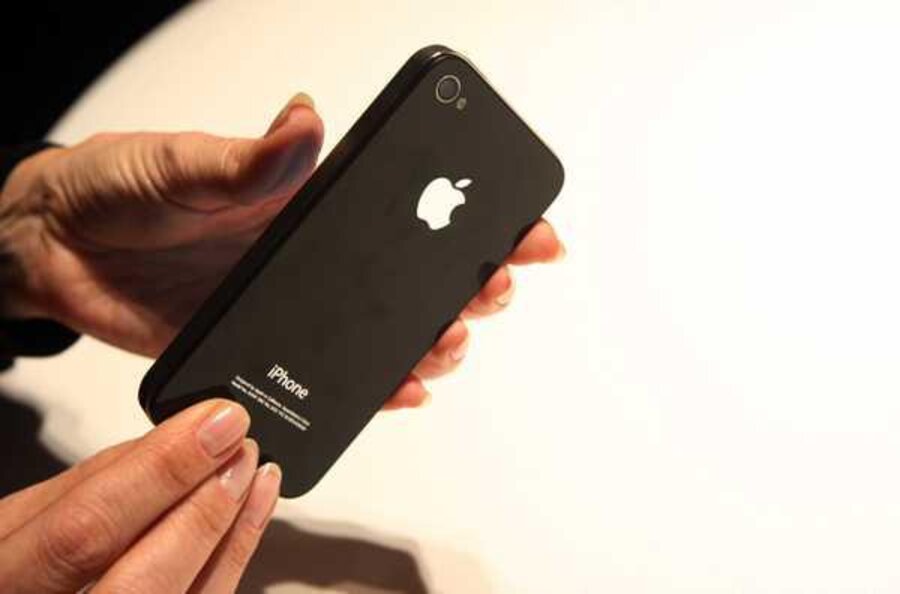iPhone filling up? Here's what to do.
Loading...
Apple released a major new software update Tuesday called iOS 7.1. The patch improves fingerprint recognition on the iPhone 5S, fixes several bugs, and adds the ability to use CarPlay in some vehicles. This is a hefty update, requiring between 250 megabytes to 325 megabytes of free storage space to download and install.
As people fill up their phones and tablets with videos, applications, photos, and music, extra storage space is in hot demand. If you don't the space required for iOS 7.1, here are a few tips for freeing up memory on your iPhone, iPad, or iPod Touch.
Step 1: Find out what's hogging space. Before you can intelligently tidy up your device, take a moment to sync it with your computer. Whenever you sync an Apple phone or tablet – whether wirelessly or by simply plugging it into your computer – iTunes will create a chart that maps out the device. This colored graph, which appears at the bottom of your iTunes window, shows how much of your storage capacity goes to audio, video, photos, apps, books, other, and free space. If any of these categories take up an inordinate amount of space, that's probably what you should tackle first.
Step 2: Rethink apps. When you download an app from the App Store, the product page will list the size of the program. Apps can vary from a third of a megabyte to multiple gigabytes. But these listings can be misleading.
Most apps create additional files that are not included in the initial megabyte count. In most cases, these extra files take up a negligible amount of space – often hundredths of a megabyte. But some can increase the size of the original app many times over. For example, the Vine app takes up 6.6 megabytes of space, according to the App Store. However, after two weeks of use, the app now takes up 57.9 megabytes of my iPhone.
You can find these more accurate numbers on the phone or tablet itself. Open the Settings app, click on "General," and then select "Usage." After a moment, it will list all of the apps on your device, in order of actual size. You can click on any of the items in this list to delete that app.
If you're looking to free up space, consider clearing out jumbo-sized apps, games that you've completed, and programs that you rarely use. Any app that you delete may be downloaded again from the same iTunes account free of charge. However, since you're also deleting the hidden, additional files that can come attached to apps, you might not be able to recover personalized settings or progress in a game.
Step 3: Consider storage in the cloud. Keeping a large library of music or photos can gobble up a lot of storage space. Photos taken with an iPhone 5S weigh in at about 2.5 megabytes each, and songs take up about a megabyte per minute of music.
If you're running out of room, maybe your device should go on a media diet. When you sync an Apple device, you can choose to transfer only certain folders and playlists. Transfer all of your images and songs to a computer and then limit what goes back onto your phone or tablet.
If that's too much hassle, you could upload your photos and songs onto the Internet and only download the files when you want them. Music mavens can try out iTunes Match, which lets you access any song that you've purchased through the iTunes store, even if that song is not currently on your device. The $25-a-year service can free up a lot of space but requires consistent access to the Internet to be useful. Of course, there are also streaming music apps, such as Spotify and Pandora, which allow you to listen to music without holding onto the music files.
As for photos, Apple gives every iPhone and iPad owner 5 gigabytes of iCloud online storage free of charge. That's room for about 2,000 iPhone photos. Apple rents additional space (up to 55 gigabytes) for $20 to $100 a year. The Dropbox app offers a similar service. It provides 2 gigabytes of free online storage, with premium tiers that reach up to 500 gigabytes.
Step 4: Take a final sweep. If you're regularly itching for space, maybe there are more systematic ways to keep your device from filling up: Opt for standard-definition videos instead of the space-hungry and more expensive highdefinition ones. Tidy up the Safari browser by opening the Settings app, selecting "Safari," and then tapping on "Clear History" and "Clear Cookies and Data."
Finally, purge old videos, books, and podcasts once you've finished them; syncing with iTunes makes it easy to decide what stays on your device and what lives on your computer.
For more on how technology intersects daily life, follow Chris on Twitter @venturenaut.








